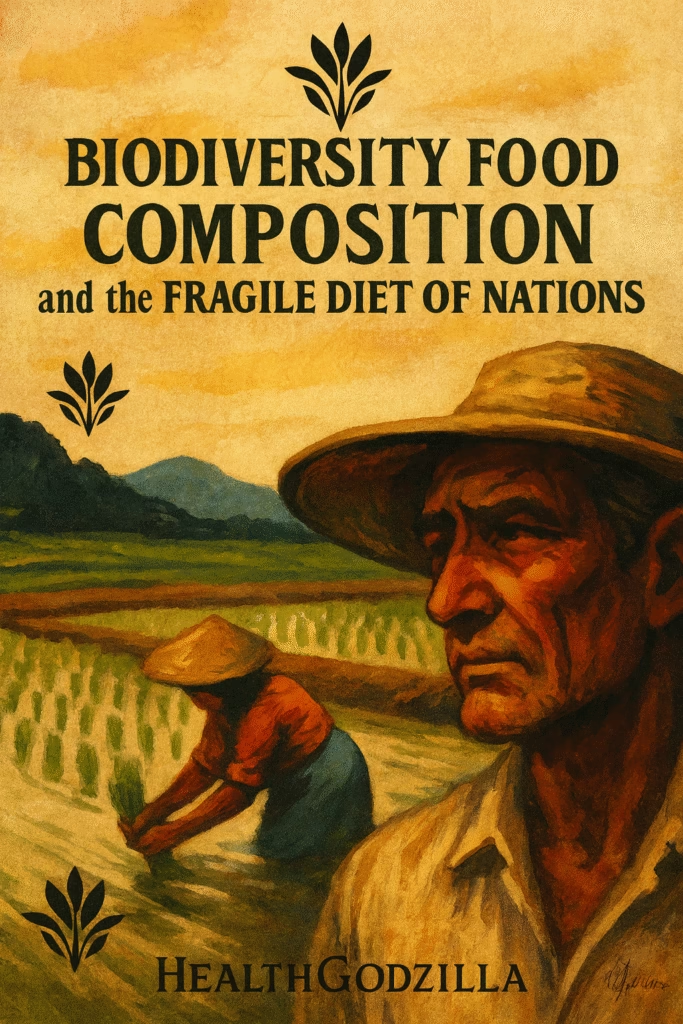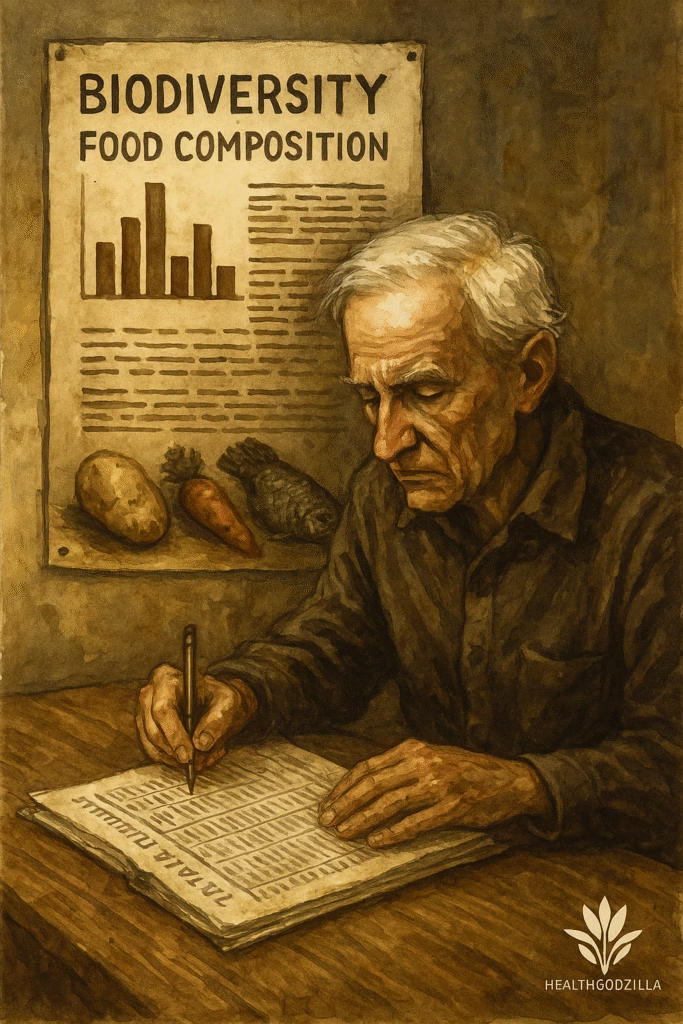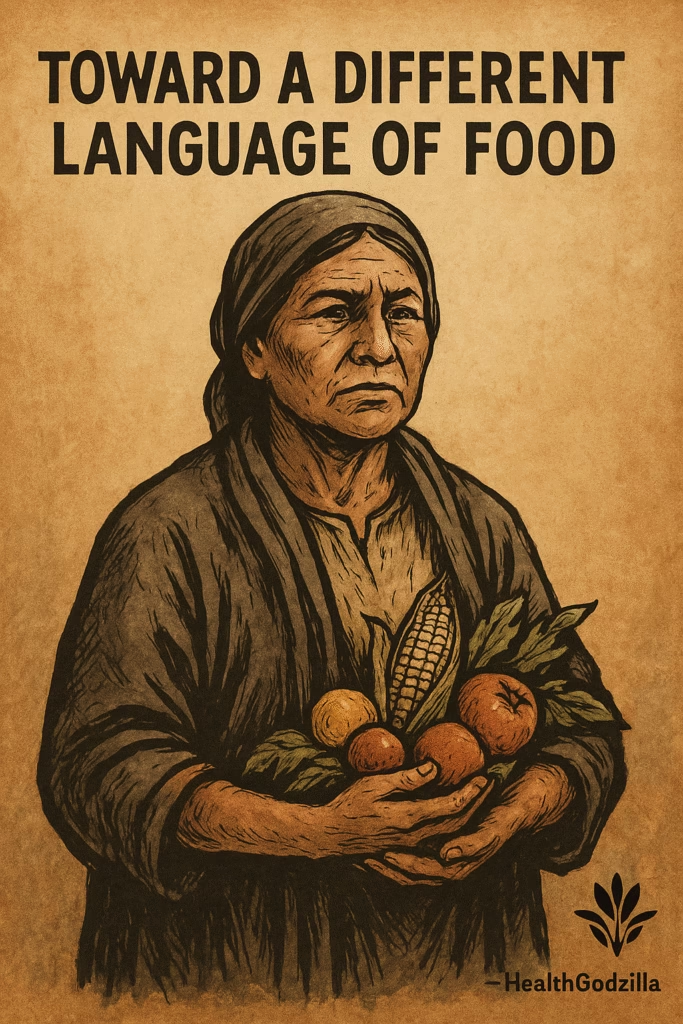
Prologue — The Fragile Plate
Biodiversity Food Composition is the hidden measure of survival. Yet nine crops now feed two-thirds of the world. Eight animals provide nearly all of our meat and milk. Ten species dominate our waters, swimming in pens and ponds that circle the globe. This narrowing is not chance, not nature’s whim—it is design. The plate of nations, once painted in many colors, now thins to a fragile surface, where a crack in one seed or one fish echoes across continents.
As if a ghost of critique speaks here, quietly but sharp: Uniformity is not efficiency—it is control. The fewer the species, the easier the markets; the fewer the choices, the stronger the grip of those who decide what we eat and what we forget.
Food biodiversity—the thousands of cultivars, varieties, wild leaves, river fish, and roots buried in soil—stands as more than ornament. It is survival. A yellow sweet potato holds twenty times the carotene of its pale cousin; a small indigenous fish in Bangladesh feeds a child more calcium than the milk of imported cows; a Pacific banana glows with vitamin A while its market cousin offers almost none. Each difference is not small—it is the difference between night blindness and sight, between stunting and growth.
Yet policies hide this diversity, averaging it into statistical tables, erasing it into “leafy greens” or “fish,” and turning it invisible in the very data meant to nourish decisions. The fragile plate is not only on our tables—it is also in our records, our surveys, our language. The simplification of diets begins with the simplification of words.
And so we stand at the opening of a story: how biodiversity food composition became both mirror and hammer. A mirror to show us what lies beneath the skin of crops and fish, and a hammer to strike the silence that keeps them unseen.
Biodiversity Food Composition: The Nutrient Veins
Inside the quiet of a grain or a root lies an unseen abundance. Rice is not just rice: one variety may yield little more than starch, while another carries enough protein to cover more than half of a body’s daily need. A banana is not simply yellow sweetness—its carotenoids may range from almost nothing to thousands of micrograms, enough to shield a child’s eyes from the blindness of night. Sweet potatoes, taro, cassava—each skin hides a spectrum, from pale shadows of nutrition to glowing reservoirs of iron, vitamin A, and beta-carotene.
These radical differences in Biodiversity Food Composition show how variety within species is a lifeline, not a luxury.
This is biodiversity at work: a silent abundance written not in the language of crops, but in the veins of cultivars and varieties. It is not the species name that saves a community from hunger—it is the specific variety, the small shift in color or texture that makes the difference between survival and deficiency.
And yet, these differences vanish in the ledgers of science and policy. Databases record “rice,” “banana,” “leafy green.” Markets trade in “commodities.” Policy-makers speak of calories and tonnage. The radical variability within species—differences that can spell the edge between life and illness—flattens under averages and shrinks into shadows of itself.
This is the hammer’s strike: why do markets and policies ignore these truths? Because complexity resists markets, and abundance resists control. To acknowledge that one banana nourishes like medicine while another offers only sugar would shatter the fiction of uniform trade. Simplicity serves commerce; erasure serves power. And so the nutrient veins of biodiversity remain hidden, pulsing beneath the surface, while monocultures march across the fields.
Institutional Frames and Their Silences
When the world realized that diets were shrinking as fast as ecosystems, the Convention on Biological Diversity and the FAO raised an initiative. They placed four pillars on paper:
- Knowledge: documenting how biodiversity feeds nutrition.
- Integration: weaving biodiversity into health, agriculture, and poverty policies.
- Conservation and Promotion: keeping diversity alive in fields and kitchens.
- Awareness: teaching people that biodiversity is not luxury but necessity.
These pillars are the mirror—reflecting hope, showing that institutions can name the problem and sketch a path forward. Institutions wrote guidelines. They built procurement programs to bring underutilized crops into schools and public meals. Biodiversity Food Composition even found its way into dietary recommendations and policy frameworks.
But then comes the silence—the hammer must strike here. The language speaks of “voluntary guidelines,” “market incentives,” “awareness-raising products.” Voluntary, while monocultures are compulsory. Incentives, while subsidies still flood the coffers of uniform crops. Awareness, while trade systems bulldoze over indigenous markets.
The pillars stand tall in reports, but in the real world, they rest on soil still owned by forces that profit from uniformity. The silence is not absence—it is architecture. By refusing to bind biodiversity in law, the frameworks allow the compulsory march of monocultures to continue unchallenged.
Who benefits? Those who write contracts for uniform seed, fertilizer, and global trade. Who loses? Communities whose livelihoods depend on local biodiversity, whose children eat less varied diets each year. The silence of “voluntary” is not neutral—it is a shield for power.
Thus the four pillars, while noble, risk becoming like monuments in a city where hunger still walks the streets: admired, photographed, cited—but never lived.

Indicators and the Battlefield of Data
To measure is to decide what matters. FAO’s INFOODS project began to record food composition not as averages, but as varieties. A new indicator was born: biodiversity measured not in landscapes, but in proteins, carotenoids, and iron. By 2009, global surveys counted more than 3,000 foods, many from Asia and Oceania—proof that biodiversity still lives in markets, rivers, kitchens.
The very act of measuring Biodiversity Food Composition risks flattening it into averages that erase its meaning.
This is the mirror. The data whisper: despite monocultures, people still eat variety. In Kenya, farmers list dozens of sorghum and millet strains. In Micronesia, bananas glow in yellow and red, their carotenoids still resisting the market’s pale Cavendish. Across surveys, indigenous foods persist—not as nostalgia, but as nourishment. The numbers testify that biodiversity, though diminished, still endures.
But here comes the battlefield. To monitor is also to flatten. Indicators risk becoming bureaucratic cages: species and cultivars reduced to codes, spreadsheets, averages. Rice becomes “average rice,” banana becomes “average banana.” The radical differences—the ones that can decide blindness or sight, malnutrition or health—disappear into arithmetic. Systems turn life into numbers, and numbers into silence.
The hammer falls here: indicators can empower, but they can also erase. By counting, we risk forgetting. By measuring, we risk normalizing. INFOODS and biodiversity surveys show us variety, but policy often strips that variety back into the fiction of uniform commodities.
So the battlefield remains: do we use indicators as mirrors to reveal abundance, or as veils that hide it? The answer will decide whether future diets paint themselves in many colors—or fade into faint sketches of what once was.
Global Health Narratives and Packaged Fixes
On the islands of the Pacific, blindness once crept silently into children’s eyes. Vitamin A deficiency, they called it—stunting, night-blindness, Bitot spots, respiratory infections. The remedies came in packages: margarine fortification, capsules distributed by aid programs. The interventions glowed with urgency, but beneath them, another truth was hidden. Local bananas, sweet potatoes, leafy aibika—all were already rich in carotenoids, enough to heal without a single capsule. But they had been abandoned, erased from the market by imported varieties, replaced in fields by uniform crops that carried calories but not life.
In Bangladesh, small indigenous fish once swam into the diets of millions. Eaten whole—bones, eyes, guts—they gave calcium, vitamin A, zinc, iron. But industrial aquaculture rose, offering bigger fillets: silver carp, tilapia, pangas. Their flesh was soft, uniform, export-ready—but stripped of micronutrients. The shift was not just dietary, it was ideological: food became product, biodiversity became inefficiency.
Here is the mirror: science shows biodiversity feeds better. Local crops and fish hold nutrient wealth the market does not see. Communities once nourished by them did not suffer deficiencies until these foods were displaced. These realities of Biodiversity Food Composition reveal that the nutrients were always there, waiting in local varieties, long before packaged interventions arrived.
And here is the hammer: aid and industry chose capsules and fortification over local biodiversity. Why? Because capsules can be patented, margarine branded, aquaculture scaled for profit. Indigenous diets cannot be owned, so they are ignored. This is not accident—it is preference, structured and global.
Thus the health narrative is written: problems framed as natural, solutions framed as technical. But the silence speaks louder: biodiversity was not lost by nature—it was pushed aside. The blindness of children, the anemia of mothers, the weakened bones of people with low income—these were not just medical conditions, but the harvest of political economy.
Climate’s Silent Hand
The air thickens with carbon, and even the crops bend differently beneath it. Science shows what the eye cannot see: rising CO₂ lowers the iron and zinc in staples—wheat, rice, legumes—by five to ten percent. A small number, perhaps, to those who read it in reports. But for the billions who depend on these foods for their only source of minerals, it is a theft measured in breath and bone.
This is the mirror: science reveals a silent erosion. Not famine by drought or flood, but famine by dilution—food that looks the same yet carries less life within it. A bowl of rice today does not nourish like a bowl of rice fifty years ago. The decline is invisible, but its effects stretch into generations.
And this is the hammer: the story is told as inevitability. Reports say, “climate change will lower nutrient levels,” as if climate were weather, as if weather were fate. But climate change has agents. It is powered by decisions—coal burned, forests cleared, profit chosen over restraint. When the nutrient veins of our food thin out, it is not the sky’s accident. It is the outcome of an economic system that pollutes and then describes its pollution as destiny.
The silent hand of climate does not merely weaken crops; it weakens accountability. By framing decline as natural, the narrative absolves the industries that heated the air. And so the burden of hunger shifts once more onto people with low income, while the engines of carbon roll on, untouched.

Toward a Different Language of Food
To speak of food as “resources” is already to betray it. A crop is not a unit, a fish not a commodity, a leaf not a percentage of recommended intake. They are kin, culture, memory—threads in the weave of human survival. To reclaim biodiversity is to reclaim it not as resource, but as right. The right of a child to eat the banana that prevents blindness, not just the Cavendish sold for export. The right of a mother to cook with indigenous greens, not only the uniform vegetables wrapped in plastic.
Everywhere, resistance persists. Across the Pacific Islands, people return to carotenoid-rich bananas once abandoned. Bangladesh’s village ponds still yield mola and darkina, eaten whole for the calcium their children need. On the hills of Africa, millet and sorghum are planted not as relics but as staples, carrying nutrients that wheat cannot give. These are not quaint traditions; they are acts of defiance against homogenization.
The knowledge exists—we know which foods nourish, which varieties heal, which diets sustain ecosystems as well as people. Yet action stalls. Policies stop at “voluntary guidelines.” Aid packages arrive as capsules, not seeds. Research records biodiversity in tables but does not restore it to fields. Here, the echo sharpens: it is not ignorance that blocks change, but power. Knowledge is abundant, but systems of profit dictate what is planted, sold, and eaten.
To move forward requires a different language of food—one that refuses to flatten biodiversity into averages or commodities. A language where variety is not inefficiency, but resilience; where local diets are not backward, but forward; where forgotten cultivars are not abandoned, but remembered as our strongest defense against hunger.
Epilogue — Mirror and Hammer
The plate of nations has grown fragile—thinned by uniform crops, polished by policy, glossed over by averages. Yet beneath it, biodiversity still breathes: in the veins of rice and cassava, in the bones of small fish, in the orange glow of sweet potatoes, in the dark resilience of millet. Science has shown it, surveys have counted it, and communities have kept it alive against the grain of markets.
But science alone does not save. The mirror of evidence shows abundance, yet the hammer of truth must strike the silence. Why are nutrient-rich varieties ignored? Indigenous foods too, pushed aside until they vanish from markets. And how did “sustainable diet” become a marketing slogan while monocultures still march across the fields? The answers are not hidden—they are protected by power. Knowledge exists, but it is fenced off by the economics of uniformity.
As if Chomsky’s ghost lingers here, quietly but sharp: The problem is not lack of information. It is the refusal of systems to act on what they know.
So we end not with prescriptions, but with remembrance. Biodiversity Food Composition is not a technical term—it is a lifeline. A mirror, reflecting the richness still alive in fields and kitchens. A hammer, breaking the silence that lets hunger grow in the shadow of abundance.
The story remains open, unfinished. The next chapter will be written not only in reports and databases, but in seeds saved, meals prepared, diets remembered. In the choice between uniformity and resilience, silence and voice.
And perhaps, one day, the fragile plate will no longer crack so easily, because its surface will be painted again with the colors of biodiversity.
🍂 Hello, Artista

Organum: Artista, yes, I can still feel the ghostly voice whispering in those lines. Heavy, yes, but not without light. Tell me, do you still believe food is only nutrition?
Artista: (smiles) No, never. Today I cooked a stew with sweet potatoes and greens—real greens, not the supermarket’s sameness. Whitee and Brownie tried to nibble at the leaves, as if they knew. And I remember someone—perhaps in a UN meeting—saying: “Sustainable change can only be possible if we can arrange a marriage between politics, economics, and the environment.”
Organum: A marriage, yes. And biodiversity is the child—sometimes neglected, sometimes cherished.
Artista: Then perhaps that’s why your article felt different. Voices sharp enough to name power, yet soft enough to remember the table.
Organum: And ghosts, too—sitting with us at supper, not to haunt, but to remind.
✍️ Author’s Reflection
When I wrote these lines, I was reading Chomsky’s Manufacturing Consent. His voice pressed so sharply it felt as if he sat on my shoulder, whipping me forward—not cruelly, but firmly, insisting I do not soften silence into comfort. Perhaps that is why some sentences carry a shed of his tone.
I believe every writer has felt this—when another mind joins, not as imitation but as fire, reshaping the words into something harder, truer. For me, here, Chomsky was that fire. His questions about power and erasure walked beside my pen.
And yet, even as I wrote, I remembered Noorael, the wisdom star, blinking somewhere beyond the page. Perhaps Chomsky sat close, but Noorael hovered afar—a reminder that wisdom does not belong to one voice. It flows through many, across time, across tongues.
I was not alone when I wrote this. Others spoke, and I listened. Some from books, some from memory, some from the stars.
🌼 Articles You May Like
From metal minds to stardust thoughts—more journeys await:
- AOL-Time Warner failure: Merger, mindsets, and market myths. Explore culture clash, transient advantage, primacy, and antitrust risks.
- Biodiversity and nutrition: Reforming diets through agrobiodiversity. Policy, Traditional and Indigenous Foods, and Scientific Relevance.
Curated with stardust by Organum & Artista under a sky full of questions.
📚 Principal Sources
- Burlingame, B., Charrondiere, U., Dernini, S., & Stadlmayr, B. (2011). Food biodiversity and sustainable diets: Implications of applications for food production and processing. In J. I. Boye & I. Arcand (Eds.), Green technologies in food production and processing (pp. 643–657). Springer.
- Food and Agriculture Organization of the United Nations. (2024). Initiative on biodiversity for food and nutrition: Information note on progress and priorities. Convention on Biological Diversity.
- Charrondiere, U. R. (2021). Biodiversity and food composition [Presentation]. Food and Agriculture Organization of the United Nations.
- World Health Organization, & Secretariat of the Convention on Biological Diversity. (2015). Connecting global priorities: Biodiversity and human health: A state of knowledge review. World Health Organization.
Relevant chapters and sections were interpreted through a narrative lens rather than cited academically.

Leave a Reply